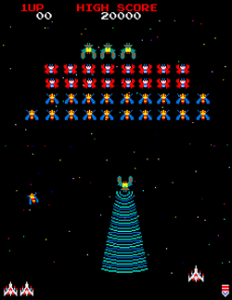Maker Faire 2011 Roundup: The Arcade
Written by ben // August 17, 2011 // Events // No comments

Arcade games have existed since the earliest pinball machines in the 1930s. The electric arcade game first appeared in 1966, and the first fully electronic arcade game appeared in 1971.
It took Pong, in 1972, to turn the arcade game into a success. Six years later, the release of Space Invaders turned it into a massive industry. Space Invaders had simple sprite graphics, animating an army of creatures that slowly advanced down the screen at the player, firing a constant barrage of bullets. The player was forced to shoot the invaders before they reached the bottom, as once they did, destruction was inevitable. The player also had four barriers that would block bullets, both from the player and aimed at the player, and which would slowly be destroyed by the firepower.
Early game consoles were extremely slow and, with all the Invaders alive, the game ran at a crawl. One source of difficulty was the changing game speed as Invaders were destroyed. Once all of its allies were defeated, the final Invader would move at a breakneck pace down the screen, giving the player mere seconds to destroy it.
 Space Invaders inspired a huge chain of game releases that are often grouped together. 1979 brought the world Asteroids, a top-down game featuring a simple spaceship clearing an asteroid belt. Shooting an asteroid caused it to split into fragments, making your life more dangerous, until finally shooting the smallest fragments would actually destroy them. 1979 also saw Galaxian, the first full-color arcade game, which could be best described as a vastly improved Space Invaders.
Space Invaders inspired a huge chain of game releases that are often grouped together. 1979 brought the world Asteroids, a top-down game featuring a simple spaceship clearing an asteroid belt. Shooting an asteroid caused it to split into fragments, making your life more dangerous, until finally shooting the smallest fragments would actually destroy them. 1979 also saw Galaxian, the first full-color arcade game, which could be best described as a vastly improved Space Invaders.
In 1980 Atari released Centipede, another game based around killing an enemy before it reached the bottom of the screen. Centipede differed in that the main enemy’s behavior, while still predictable, was far more complex than previous games. Instead of the empty void of space featured by Space Invaders and Galaxian, Centipede had a game field littered by mushrooms, which would influence the movement of the eponymous Centipede. Worse, enemy spiders and fleas would change the game field as they traveled, making the gameplay far more dynamic than most previous games.
 Pac-Man was also released in 1980, quickly becoming a world-recognized gaming icon. Pac-Man travels through a maze, eating dots and dodging ghosts. While the ghost AI was simple, the interactions between the ghosts caused them to be surprisingly good at cornering the player. Unlike most of the other classic arcade games, the Pac-Man franchise has survived for decades, and new Pac-Man games have been released as recently as 2010.
Pac-Man was also released in 1980, quickly becoming a world-recognized gaming icon. Pac-Man travels through a maze, eating dots and dodging ghosts. While the ghost AI was simple, the interactions between the ghosts caused them to be surprisingly good at cornering the player. Unlike most of the other classic arcade games, the Pac-Man franchise has survived for decades, and new Pac-Man games have been released as recently as 2010.
Donkey Kong was released in 1981, introducing the gaming industry to Mario and Donkey Kong himself. This game involved Mario traveling through an industrial construction zone, dodging flaming barrels and other hazards, to rescue a girl named Pauline from Donkey Kong. It contained four distinct levels, as well as an unspoken plotline, which was conveyed through gameplay and cutscenes.
Also in 1981 was Galaxian’s sequel, Galaga, as well as Ms. Pac-Man, a somewhat unofficial sequel to Pac-Man. These games preserved the basic gameplay of the originals while improving upon it. Galaga gained a new “boss enemy” mechanic that, if exploited properly, would let the player pilot two ships, while Ms. Pac-Man added several more levels and a basic plotline.
 We received a large number of votes for the above games, and a smaller number for several other arcade games. Defender, 1980. Battlezone, 1980. Missile Command, 1980. Frogger, 1981. With only one exception, all of the major arcade games that we received votes for were released between 1979 and 1981. That one exception: Joust, released in 1982.
We received a large number of votes for the above games, and a smaller number for several other arcade games. Defender, 1980. Battlezone, 1980. Missile Command, 1980. Frogger, 1981. With only one exception, all of the major arcade games that we received votes for were released between 1979 and 1981. That one exception: Joust, released in 1982.
It seems clear that the golden age of classic arcade creations was the late 70’s and early 80’s. This time period stands out strongly in the data we collected.

